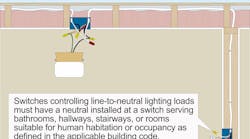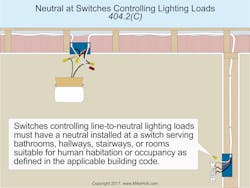Q. Does the NEC require the installation of a neutral conductor in switch boxes?
Scroll Down to See the Answer
Underlined text indicates a change in the rules for the 2017 NEC.
A. Switches controlling line-to-neutral lighting loads must have a neutral conductor installed at a switch serving bathrooms, hallways, stairways, or rooms suitable for human habitation or occupancy as defined in the applicable building code [404.2(C)], as shown in the Figure. Where 3-way and 4-way switches are visible in a room, only one of the switches requires a neutral conductor.
A neutral conductor isn’t required under any of the following conditions:
(1) Where conductors enter the box through a raceway with sufficient cross-sectional area to accommodate a neutral conductor.
(2) Where the switch box can be accessed to add or replace a cable without damaging the building finish.
(3) Snap switches with integral enclosures [300.15(E)].
(4) Where the lighting is controlled by automatic means.
(5) Switches controlling receptacles.
The neutral conductor must be run to any replacement switch that requires line-to-neutral voltage [404.22] to operate the electronics of the switch in the standby mode.
Exception: A neutral conductor isn’t required for replacement switches installed in locations wired prior to the adoption of Sec. 404.2(C) where the neutral conductor can’t be extended without removing finish materials. The number of electronic lighting control switches without a neutral conductor on a branch circuit must not exceed five switches, and the number connected to any feeder must not exceed 25 switches.
Informational Note: The purpose of the neutral conductor at a switch is to complete a circuit path for electronic lighting control devices that require a neutral conductor.
These materials are provided to us by Mike Holt Enterprises in Leesburg, Fla. To view Code training materials offered by this company, visit www.mikeholt.com/code.





